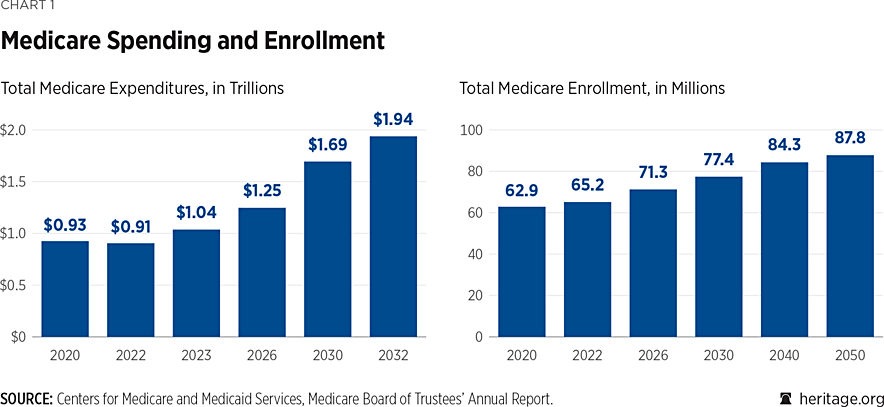The Issue
Once again, the Medicare Board of Trustees’ Annual Report warns of the program’s unsustainable financial condition, the threat to seniors’ access, and the huge financial burdens facing American taxpayers. Congressional action is needed, the sooner the better, to stabilize Medicare’s finances. Carefully crafted reforms can not only improve the program’s solvency but can also enhance the delivery of care for current and future beneficiaries.
Key Warnings from the Trustees’ Annual Report
- The Hospital Insurance (HI) Trust Fund Warning. The Trustees announced that the Medicare Part A/Hospital Trust Fund, based on their “intermediate” estimates, will be exhausted in 2036, resulting in an 11 percent benefit payment cut and threatening patient access to care (p. 6). While the latest insolvency date was pushed back from 2031 to 2036, the reprieve is short-lived, and yearly deficits will afterwards deepen. While the Trustees say that HI trust fund assets should equal 100 percent of yearly expenditures, in 2024 they only account for 50 percent (p. 26). Meanwhile, the number of workers contributing to each beneficiary will fall from nearly three to just 2.5 by 2030. So, that is why the HI program meets neither short-term nor long-term Trustee standards of “financial adequacy” (pp. 26–31).
- The “Trigger” Warning. Aside from the depletion of the Part A Trust Fund, if general revenues needed to support Medicare Part B (physician and outpatient services) and Part D (prescription drug coverage) exceed 45 percent of total Medicare expenditures within 7 years, the Trustees must issue a “trigger warning,” which by law is to direct the administration to submit a plan to Congress for remedial action. This is the seventh consecutive year that the Trustees issued the warning, but previous presidential administrations and congressional leaders have routinely ignored them (p. 8).
- The Unfunded Obligation Warning. Taxpayers are responsible for Medicare’s unfunded obligations—the estimated cost of promised Medicare benefits that are not covered by either dedicated revenues or premiums. Over the next 75 years, the Trustees calculate that the unfunded obligations amount to $52.8 trillion (in today’s dollars) (p. 208).
The Status Quo Harms Seniors and Taxpayers
Facing rapidly rising costs and demographic shifts, seniors and taxpayers will be hardest hit. Today, total Medicare expenditures reached more than $1 trillion and are expected to reach over $2 trillion by 2033 (p. 177), while the number of enrollees soars from more than 66 million today to over 80 million by 2033 (p. 181).
- Seniors. Rising Medicare costs means Medicare premiums will go up, of course, and since these premiums are automatically deducted from their Social Security, seniors’ monthly Social Security checks will get smaller. In 2023, the standard monthly Part B premiums was $164.90 (with an annual deductible of $240.00) and is projected to rise to $299.80 (with an annual deductible of $421.00) in 2033 (p. 198). The Trustees note that today the combination of premiums and cost sharing for Parts B and D consumes about 26 percent of the average Social Security benefit (p. 40). Expect that benefit erosion to intensify over the next 10 years.
- Taxpayers. Rising Medicare costs guarantee that taxpayers will face much higher taxes. In 2022, annual government contributions to Medicare, automatic drawdowns from the federal treasury, consumed an estimated 13.3 percent of all personal and corporate federal income taxes. By 2040, the general revenue transfers will consume 26.7 percent of all such taxes (p. 41). Further, what was purported as a “wealth” tax, the additional Obamacare income tax on individuals with income over $200,000 ($250,00 for couples) was not indexed for inflation. So, the Trustees’ report says, “[b]y the end of the long-range period (75 years), an estimated 80 percent of workers would be subject to this additional tax” (p. 29).

More Price Controls Not the Answer
Efforts to address Medicare’s fiscal challenges through tougher price controls or payment caps is a “lose-lose” proposition.
- Part A Payments. Under the Medicare bureaucracy’s price controls, hospitals today are paid at 60 percent of private rates. Based on estimates of the Centers for Medicare and Medicaid Services’ Office of the Actuary, the Trustees’ report finds: “By 2040 simulations suggest that roughly one-third of hospitals and over 50 percent of skilled nursing facilities and home health agencies would have negative total facility margins, raising the possibility of access and quality of care issues for Medicare beneficiaries” (p. 189).
- Part B Payments. Today, Medicare doctors are paid at 72 percent of private rates, struggle to keep up with their own costs, and are already facing future rate reductions. The Trustees thus report: “Absent a change in the delivery system or level of update by subsequent legislation, the Trustees expect access to Medicare-participating physicians to become a significant issue in the long term” (p. 190).
A Better Medicare
Congress and successive Administrations have routinely ignored the Trustees’ warnings. The Biden Administration is no different. If policymakers are serious about protecting Medicare, they must act.
- Build on What Works. Congress can build upon the best features that already exist in Medicare. The Medicare Advantage program is a defined-contribution, patient-choice model that harnesses the benefits of choice and competition. These private plans have attracted over half of all Medicare enrollees, and already deliver standard Medicare benefits at a cost below that of traditional Medicare itself. With targeted reforms, Medicare Advantage can serve as the platform to strengthen and sustain Medicare well into the future.
- Leverage the Advantages of Choice and Competition. Pro-market, pro-competition policies would not only improve the availability and quality of care, but it would also slow the growth of Medicare spending and secure savings for seniors and taxpayers alike. Former Congressional Budget Office Director Doug Holtz-Eakin estimates that a fully competitive Medicare program based on a defined-contribution model, would save an estimated $2.2 trillion over 10 years, including $333 billion in direct beneficiary savings.
- Start Sooner Rather Than Later. There is no time to waste. The longer the White House and congressional leaders put off addressing the inevitable crisis, the more difficult the choices. The sooner solutions are enacted, the more gradual, flexible, and less disruptive they can be.




